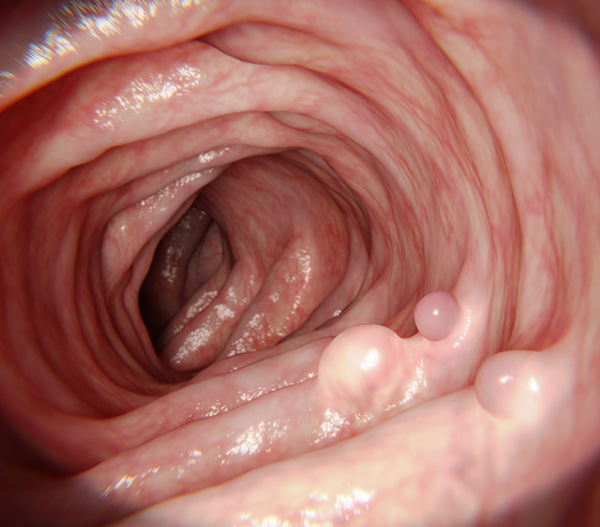Colon Cancer and Polyps
Colon cancer is a common cancer affecting the large intestine. Individuals at increased risk include those with prior history of colon cancer, a family history of colon cancer, a history of polyps, older age, diet high in protein, obesity, and smoking. In many the disease has no symptoms and is detected during a colonoscopy. In others it may present as a change in bowel habits, bleeding per rectum, unintentional weight loss, anemia, bloating, cramping, or abdominal pain.
 Colon Cancer
Colon Cancer Colon polyp
Colon polyp
A colon polyp an outgrowing of the inner lining of the colon. Most polyps are non-cancerous. However, the adenomatous type of polyps can progress to form cancer. Large or flat polyps are more likely to contain cancer cells. Depending on the size and nature of the polyp, your gastroenterologist may attempt removal during colonoscopy or recommend colectomy surgery. Colectomy for colonic polyps is very similar to that for colon cancer.
Once colon cancer is identified, the mainstay of treatment is surgical resection. The procedure is called colectomy. It is performed under general anesthesia, and can be performed through an open, laparoscopic, or robotic approach. Open colectomy is performed through a midline incision. Laparoscopic and Robotic colectomies are performed through multiple small incisions, thereby reducing trauma and minimizing post-operative pain. On average a laparoscopic or Robotic colectomy takes 2-3 hours to complete.
Due to their less invasive approach, Laparoscopic and Robotic colectomy are associated with earlier return of bowel function, shorter hospital stays, and decreased need for pain medications after surgery as compared to open colectomy. From a cancer treatment standpoint, safety and efficacy of treatment of colon cancer between open, laparoscopic, and robotic colectomy are similar, as investigated in numerous randomized controlled trials.
Dr. Zaré has been offering minimally invasive colon resection since 2002. Initially, majority of his procedures were performed laparoscopically, resulting in reduced pain and hospital stay when compared to open resections. In 2014, significant advances occurred in robotic technology, allowing complex procedures such as colon resection to be performed robotically with great success. Robotic platform offered by Intuitive Surgical (Da Vinci Xi system) provides instruments with wristed motion for complex maneuverability, and 3D optics with 10X magnification for precise visualization and depth perception. Robotic stapling platform identifies tissue thickness and aids in preventing misfires. As a whole, robotic approach increases precision, decreases potential trauma, and enhances the recovery process. Dr. Zaré began offering robotic colon resection in 2014, performing some of the earliest robotic colectomies in Northern California. While patients undergoing laparoscopic colon resection already experience superior outcomes compared to their open counterparts, those undergoing robotic surgery experience even better outcomes. For example, the average length of stay for open colon resection is 7 days. It is reduced to 4 days for laparoscopic resection, and 1-3 days for robotic resection. The need to convert to open surgery occurs in less than 5% of the procedures.
After surgery, a pathologist examines the resected cancer to determine the extent of the disease. The pathologic diagnosis along with other radiographic staging work up such as computed tomography (CT) scan will determine the stage of the cancer. Patients with advanced cancer with spread to surrounding lymph nodes or distant sites may require additional treatment after surgery, in the form of chemotherapy or radiation. Fortunately, if colon cancer is detected in an early stage, over 90% of patients will remain cancer free for at least five year or longer. For this reason, colon cancer is considered to be one of the most treatable forms of cancer.

